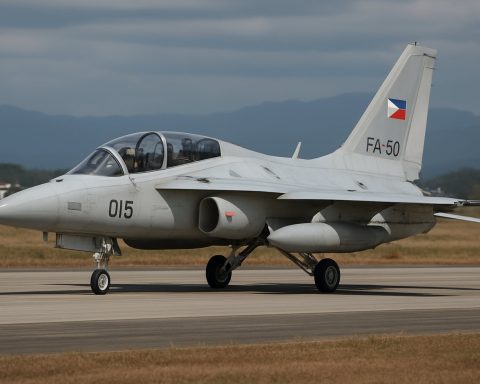- The J-36 is a new Chinese aircraft featuring a unique trijet configuration, stirring global attention and intrigue.
- The design includes three engines, enhancing thrust and redundancy for combat effectiveness.
- Experts suggest the J-36’s design could allow for large internal weapons bays, positioning it as a formidable strike platform.
- The J-36 signals a potential shift in air superiority, challenging Western dominion historically held by the F-22 and F-35.
- The U.S. is countering with its own innovations, like the F-47, reportedly featuring advanced modular swarm capabilities.
- China’s future aircraft projects, such as the mysterious J-XX or J-50, underscore its commitment to leading in aerial warfare.
- The global landscape for military aviation is on the brink of transformation, with nations strategizing for airspace dominance.
A sleek silhouette, devoid of a tail but brimming with mystery, slices through the skies over Chengdu. This is China’s J-36, a revolutionary aircraft whose debut footage has sparked intense global fascination. It’s not just another fighter jet but a statement, a harbinger of potential future air supremacy.
The J-36 distinguishes itself with an unusual trijet configuration that deviates from conventional designs. Two intakes comfortably nestle under its wings, while a third perches behind the cockpit. This unique engine layout promises enhanced thrust and redundancy, vital for any combat scenario.
Military aviation experts, like former Italian Air Force officer David Cenciotti, keenly dissect this unorthodox design. They suggest that the spacious underbelly of the J-36 might house expansive internal weapons bays, perfectly tailored for large, long-range missiles. The tantalizing suggestion here is clear: this aircraft isn’t merely a fighter; it’s a formidable strike platform.
This innovative direction suggests a paradigm shift in military aviation. Where the United States has long held dominance with its F-22 and F-35 jets, the J-36 represents a whisper of a future where China could challenge, or even surpass, its Western counterparts. Brad Lendon reinforces this notion; the J-36 might catapult China into the leading position in the race for sixth-generation fighter jets.
Echoing across the Pacific, former President Donald Trump announced advancements in the United States’ own sixth-generation effort. The F-47, draped in secrecy and speculation, allegedly soars with a swarm of companion drones. This modular approach heralds a new era of air combat—an aerial orchestra directed by a single maestro jet.
Yet, China isn’t pausing for applause. Lurking in the shadows, the J-XX or J-50 emerges—a twin-engine mystery ready to confront any airborne challenge. While official confirmations are elusive, the implications are vivid. China is not just participating but actively shaping the future of aerial warfare.
As the haze of competitive fervor lifts, the world stands on the brink of an aviation renaissance. The J-36, with its radical design and unknown capabilities, serves as a capable herald of what lies ahead. The skies are set to become more contested, the stakes higher, the race more exhilarating than ever before.
It’s a global game of aerial chess: kings, queens, and shadowy pawns moving deftly across the board. As China unveils pieces shrouded in mystery, the world watches. The next move? It remains far from clear, but one truth emerges: the airspace above us has never been more strategic or more fiercely contested.
China’s J-36: A Game-Changer in Aerial Combat Technology?
Overview of the J-36
The unveiling of China’s J-36 fighter jet has sent ripples through the global military aviation community. With its sleek design and trijet configuration, the J-36 breaks from traditional aircraft norms, marking a significant advancement in China’s aerospace capabilities. The aircraft is seen as a potential leap towards dominating future aerial warfare.
Unique Features of the J-36
– Trijet Configuration: The J-36 features a distinctive trijet engine setup, a rarity among modern fighter jets. This configuration could offer improved thrust and redundancy, critical for withstanding combat scenarios.
– Internal Weapons Bay: Speculation suggests that the aircraft’s spacious underbelly might house large, long-range missiles. This setup positions the J-36 not just as a fighter, but a potent strike platform capable of carrying out strategic missions.
– Potential for Sixth-Generation Warfare: Analysts like David Cenciotti emphasize that the J-36’s novel design elements point towards China’s ambition to lead in sixth-generation warfare, challenging the dominance of jets like the U.S. F-22 and F-35.
Market Forecasts & Industry Trends
With the J-36’s debut, the global fighter jet market is poised for significant shifts:
– Increasing Competition: As China pushes forward with the J-36 and possibly the J-XX/J-50, the competition among global powers to develop advanced fighter jets is expected to intensify.
– Investment in Domestic Aerospace: Countries are likely to increase investment in their domestic aerospace industries to keep pace with innovations, leading to potential collaborations and technological exchanges.
Comparisons & Limitations
While the J-36 is garnering attention, it’s important to compare it with its peers:
– Comparison: The U.S. F-22 and F-35 have set benchmarks in stealth, agility, and multi-role capabilities. While the J-36’s potential is promising, real-world performance metrics against these benchmarks remain to be seen.
– Limitations: Details about the J-36’s avionics and sensor capabilities remain sparse, leaving experts to question its battlefield effectiveness and network integration.
Insights & Predictions
– Strategic Implications: Should the J-36 and other potential Chinese models like the J-XX gain operational status, it could alter the balance of power in the Asia-Pacific region and beyond.
– Future Development: China’s commitment to advancing its military aviation well beyond the J-36 suggests ongoing developments, which could result in more innovations in the near future.
Pressing Questions
1. What is the expected timeline for the J-36 to become fully operational?
– While official timelines are not public, analysts predict a phased approach to testing before full deployment, possibly within the next decade.
2. How does the J-36 impact global military alliances and partnerships?
– As China advances technologically, allied countries might seek closer collaborations or enhance their own defense capabilities to maintain strategic parity.
Actionable Recommendations
– Keep Informed: For enthusiasts and stakeholders, staying updated with credible defense analysis and official releases will be crucial in understanding the J-36’s evolution.
– Strategic Planning: Countries and companies involved in defense contracts should consider investing in next-generation aviation technologies and partnerships.
For further details on developments in military aviation, visit Defense.gov.
As the world navigates this new chapter in military aerospace, the central lesson is clear: in the game of aerial chess, strategic foresight and adaptability will be key to staying ahead.







